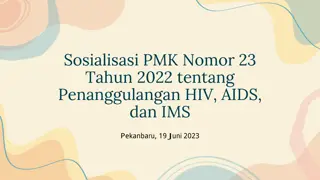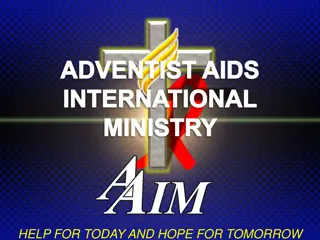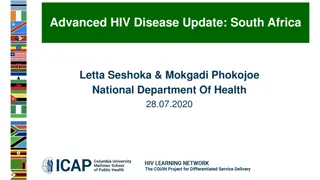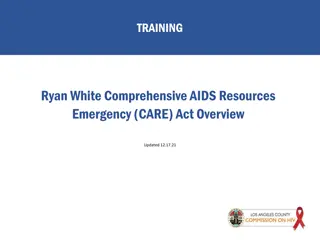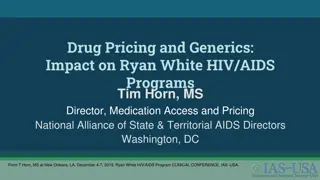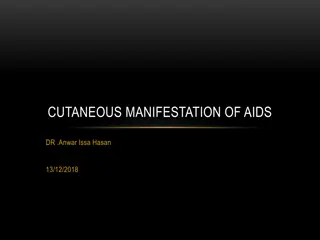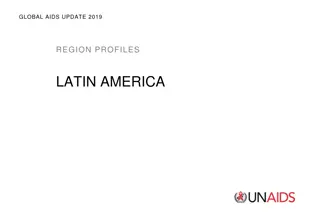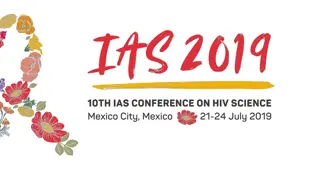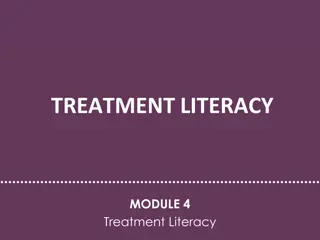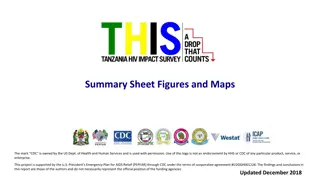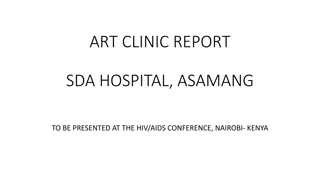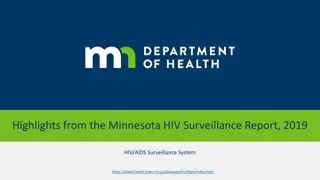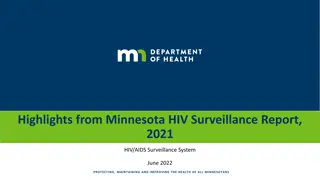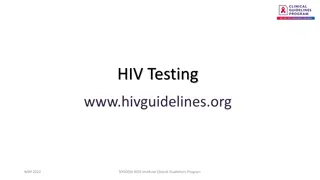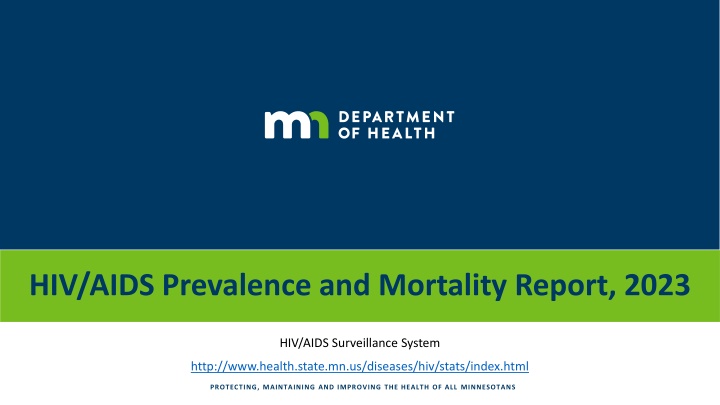
HIV/AIDS Prevalence and Mortality Report 2023 in Minnesota
This report provides estimates on the number of persons living with HIV/AIDS and mortality in Minnesota, based on data from cases diagnosed through 2022. Data analyses exclude certain populations and highlight limitations of surveillance data.
Download Presentation

Please find below an Image/Link to download the presentation.
The content on the website is provided AS IS for your information and personal use only. It may not be sold, licensed, or shared on other websites without obtaining consent from the author. If you encounter any issues during the download, it is possible that the publisher has removed the file from their server.
You are allowed to download the files provided on this website for personal or commercial use, subject to the condition that they are used lawfully. All files are the property of their respective owners.
The content on the website is provided AS IS for your information and personal use only. It may not be sold, licensed, or shared on other websites without obtaining consent from the author.
E N D
Presentation Transcript
HIV/AIDS Prevalence and Mortality Report, 2023 HIV/AIDS Surveillance System http://www.health.state.mn.us/diseases/hiv/stats/index.html PROTECTING, MAINTAINING AND IMPROVING THE HEALTH OF ALL MINNESOTANS
Introduction (I) These three introduction slides provide a general context for the data used to create this slide set. If you have questions about any of the slides, please refer to the Surveillance Technical Notes. This slide set displays estimates of the number of persons living with HIV/AIDS (prevalence) and mortality in Minnesota by person, place, and time. The slides rely on data from HIV/AIDS cases diagnosed through 2022 and reported to the Minnesota Department of Health (MDH) HIV/AIDS Surveillance System, which is part of the National HIV/AIDS Surveillance System (NHSS). 2
Introduction (II) Data analyses exclude persons diagnosed in federal or private correctional facilities, but include state prisoners (number of state prisoners believed to be living with HIV/AIDS as of 2023 = 16) Data analyses for new infections exclude persons arriving in Minnesota through the HIV+ Refugee Resettlement Program (number of primary HIV+ refugees in this program living in Minnesota as of December 31, 2023 = 161), as well as other refugees/immigrants reporting a positive test prior to their arrival in Minnesota (n = 154). Some limitations of surveillance data: Do not include HIV-infected persons who have not been tested for HIV Do not include persons whose positive test results have not been reported to MDH Do not include HIV-infected persons who have only tested anonymously Case numbers for the most recent years may be undercounted due to delays in reporting Reporting of living cases that were not initially diagnosed in Minnesota is known to be incomplete, as well as transfer of living cases that have moved to other states from Minnesota. However, since 2018, every jurisdiction funded for HIV surveillance by CDC has been part of a deduplication project in the National HIV Surveillance System. 3
Introduction (III) Persons are assumed to be alive unless MDH has knowledge of their death. Persons whose most recently reported state of residence was Minnesota are assumed to be currently residing in Minnesota unless MDH has knowledge of their relocation. Our ability to track changes of residence, including within the state, is limited and subject to reporting delays and incomplete case and lab reporting. Vital status and current residence are updated through one or more of the following methods: Standard case and lab reporting Correspondence with other health departments Active surveillance Death certificate reviews (at least annually) Birth certificate reviews (at least annually, pregnant persons only) 4
HIV prevalence | 2021 | Ages 13 years and older | All races/ethnicities | Both sexes | All transmission categories | US Map-State Level 193.0 per 100,000 people Rate per 100,000 among selected population US Virgin Islands Alaska Guam N Mariana Islands American Samoa Puerto Rico Hawaii District of Columbia 2.8 - 128.8 129.1 - 210.2 214.5 - 318.1 332.5 - 411.4 415.3 - 2381.8 Footnotes: Data for 2022 and 2023 are preliminary and based on data received by CDC as of September 2023. Inclusion of preliminary data in trend assessments is discouraged. See Notes on second slide for details. Prevalence data for 2022 are preliminary and based on death data received by CDC as of December 2022. Prevalence data prior to 2010 are based on residence at diagnosis; prevalence data from 2010 to present based on most recent known address. ^ Jurisdiction with incomplete reporting of deaths for most recent year. NA - Not Applicable.
AIDS prevalence | 2021 | Ages 13 years and older | All races/ethnicities | Both sexes | All transmission categories | US Map-State Level 84.6 per 100,000 people Rate per 100,000 among selected population US Virgin Islands Alaska N Mariana Islands American Samoa Puerto Rico Hawaii District of Columbia Guam 0 24.1 - 61.1 62.6 - 103.1 106 - 148 148.6 - 209.9 210.8 - 1264.2 Footnotes: Data for 2022 and 2023 are preliminary and based on data received by CDC as of September 2023. Inclusion of preliminary data in trend assessments is discouraged. See Notes on second slide for details. Prevalence data for 2022 are preliminary and based on death data received by CDC as of December 2022. Prevalence data prior to 2010 are based on residence at diagnosis; prevalence data from 2010 to present based on most recent known address. ^ Jurisdiction with incomplete reporting of deaths for most recent year. NA - Not Applicable.
AIDS deaths | 2021 | Ages 13 years and older | All races/ethnicities | Both sexes | All transmission categories | United States Footnotes: Data for 2022 and 2023 are preliminary and based on data received by CDC as of September 2023. Inclusion of preliminary data in trend assessments is discouraged. See Notes on second slide for details. Death data for 2022 are preliminary and based on death data received by CDC as of December 2022. Death data for 2020 and 2021 should be interpreted with caution due to excess deaths in the United States population attributed to the COVID-19 pandemic. For additional information, see https://www.cdc.gov/nchs/nvss/vsrr/covid19/excess_deaths.htm. Death data based on residence at death. ^ Jurisdiction with incomplete reporting of deaths for most recent year. NA - Not Applicable.
New HIV Diagnoses, HIV (non-AIDS) and AIDS Cases by Year of HIV Diagnosis, 2012 2023 2012 314 237 275 77 2013 302 218 263 85 2014 311 234 244 76 2015 302 234 216 69 2016 303 242 196 61 2017 282 217 213 66 2018 285 227 193 60 2019 275 221 182 57 2020 230 186 152 43 2021 298 238 175 60 2022 262 223 141 39 2023 324 258 158 67 HIV Disease Diagnoses* HIV (non-AIDS) AIDS Total^ AIDS at first diagnosis^^ AIDS (progressed)^^^ 198 178 168 147 135 147 133 125 109 115 102 91 *Includes all new cases of HIV infection (both HIV (non-AIDS) and AIDS at first diagnosis diagnosed within a given calendar year. ^Includes all cases diagnosed with HIV in that year who subsequently progressed to AIDS diagnosis status, including those diagnosed with AIDS when they were first diagnosed with HIV^^ and those who were diagnosed with AIDS in subsequent years^^^ This includes refugees in the HIV+ Resettlement Program, as well as, other refugee/immigrants diagnosed with AIDS subsequent to their arrival in the United States. 10
Estimated Number of Persons Living with HIV/AIDS in Minnesota As of December 31, 2023 9,996* persons are assumed alive and living in Minnesota with HIV/AIDS. This includes: 5,767 (58%) living with HIV infection (non-AIDS) 4,229 (42%) living with AIDS This number includes 2,807 persons who were first reported with HIV or AIDS elsewhere and subsequently moved to Minnesota This number excludes 1,822 persons who were first reported with HIV or AIDS in Minnesota and subsequently moved out of state *This number includes persons with Minnesota reported as their current state of residence, regardless of residence at time of diagnosis. It also includes state prisoners and refugees arriving through the HIV+ Refugee Resettlement Program, as well as HIV+ refugees/immigrants arriving through other programs. 12
Minnesotans Living with HIV# by County of Current Residence, 2023 City of Minneapolis City of St. Paul Suburban* Greater Minnesota Total** 3,248 (764.1 per 100,000) 1,137 (375.0 per 100,000) 3,694 (152.6 per 100,000) 1,903 (88.3 per 100,000) 9,982 (174.6 per 100,000) #HIV or AIDS at last medical appointment *7-county metro area, excluding the cities of Minneapolis and St. Paul **Residence information is missing for 14 people Data: HIV/AIDS Prevalence and Mortality Report 2023 Tables (PDF) 14
Minnesotans Living with HIV by Metro* County, 2023 City of Minneapolis City of St. Paul Suburban* Greater Minnesota Total** 3,248 (764.1 per 100,000) 1,137 (375.0 per 100,000) 3,694 (152.6 per 100,000) 1,903 (88.3 per 100,000) 9,982 (174.6 per 100,000) *7-county metro area, excluding the cities of Minneapolis and St. Paul **Residence information is missing for 14 people Data: HIV/AIDS Prevalence and Mortality Report 2023 Tables (PDF) 15
Persons Living with HIV/AIDS in Minnesota by Current Residence, 2023 *14 persons missing county-level residence information Suburban includes the 7-county metro area of Anoka, Carver, Dakota, Hennepin (except Minneapolis), Ramsey (except St. Paul), Scott, and Washington counties. Greater Minnesota includes all other counties outside of the 7-county metro area. Data: HIV/AIDS Prevalence and Mortality Report 2023 Tables (PDF) 16
Sex Assigned at Birth, Gender Identity, and Race/Ethnicity
Transmission Categories CDC defines Transmission categories as the term for classification of cases that summarizes an adult s or adolescent s possible HIV risk factors; the summary classification results from selecting, from the presumed hierarchical order of probability, the single risk factor most likely to have been responsible for transmission. Male-to-male sexual contact (MMSC): includes individuals assigned male sex at birth, regardless of current gender identity, who have had sexual contact with other males, and individuals assigned male sex at birth who have had sexual contact with both males and females (bisexual contact) Injection drug use (IDU): includes persons who injected nonprescription drugs or who injected prescription drugs for nonmedical purposes Male-to-male sexual contact and injection drug use (MMSC/IDU): includes individuals assigned male sex at birth, regardless of current gender identity, who have had sexual contact with other males and injected nonprescription drugs or injected prescription drugs for nonmedical purposes Heterosexual contact: includes persons who have ever had sexual contact with a person known to have, or with a risk factor for, HIV infection Perinatal: includes persons who acquired HIV through mother-to-child transmission Other: includes persons with other risk factors (ie. blood transfusion, hemophilia) or whose risk factor was not reported or identified The Minnesota Department of Health, STI/HIV/TB Section also recognizes current gender identity when trying to understand HIV transmission between groups of people Transgender women who have sex with men (TWSM): includes individuals assigned male at birth, that identify as female who have had sexual contact with male(s) Transgender women who have sex with men and injection drug use (TWSM/IDU): includes individuals assigned male at birth, that identify as female who have had sexual contact with male(s) AND injected nonprescription drugs or injected prescription drugs for nonmedical purposes Technical Notes | Volume 33 | HIV Surveillance | Reports | Resource Library | HIV/AIDS | CDC 18
Gender Identity Gender identity refers to a person s internal understanding of their own gender, or gender with which a person identifies. HIV surveillance personnel collect data on gender identity, when available, from sources such as case report forms submitted by health care or HIV testing providers and medical records, or by matching with other health department databases Cisgender is a term used to indicate that a person s sex assigned at birth and current gender identity are the same (ie. a person assigned male at birth and who currently identifies as a man is a cisgender male) Transgender woman: a person assigned male sex at birth who identifies as female Transgender man: a person assigned female sex at birth who identifies as male Technical Notes | Volume 33 | HIV Surveillance | Reports | Resource Library | HIV/AIDS | CDC 19
Persons Living with HIV/AIDS in Minnesota by Sex Assigned at Birth, 2023 20
Persons Living with HIV/AIDS in Minnesota by Sex Assigned at Birth and Race/Ethnicity^, 2023 *Other includes multi-racial persons and persons with unknown race ^Race/ethnicity information missing for 3 PWH. Race is a social construct. While there are health disparities between racial and ethnic groups, these are driven by underlying factors relating to historical traumas and current systematic impacts of those traumas. Data: HIV/AIDS Prevalence and Mortality Report 2023 Tables (PDF) 21
Persons Living with HIV/AIDS in Minnesota by Gender Identity** and Race/Ethnicity^, 2023 *Other includes multi-racial persons and persons with unknown race ^Race/ethnicity information missing for 2 PWH. Race is a social construct. While there are health disparities between racial and ethnic groups, these are driven by underlying factors relating to historical traumas and current systematic impacts of those traumas. **Current gender was not reportable until 2009, so may be incomplete for HIV infections reported before that time. Because current gender is incomplete for a large number of cases, there may be misclassification of transgender Minnesotans in the cisgender group. Data: HIV/AIDS Prevalence and Mortality Report 2023 Tables (PDF) 22
Number of Cases and Rates (per 100,000 persons) of Persons Living with HIV/AIDS by Race/Ethnicity** in Minnesota, 2023 Race/Ethnicity Number of Cases Percentage of Total Rate per 100,000^ White, non-Hispanic 4121 41% 92.9 Black, non-African-born 2,038 20% 733.4 Black, African-born* 1,714 17% 1,180.3 Hispanic 1,254 13% 367.3 American Indian 120 1% 200.3 Asian/Pacific Islander 243 2% 77.8 Other 503 5% 181.9 Total 9,993 100% 174.8 ^2022 CDC Wonder used for rate calculations, except where otherwise specified. **Race/ethnicity information missing for 3 PWH. Race is a social construct. While there are health disparities between racial and ethnic groups, these are driven by underlying factors relating to historical traumas and current systematic impacts of those traumas. *African-born refers to Blacks who reported an African country of birth. Non African-born refers to all other Blacks. Rates for black, non African-born and black, African-born are not comparable to previous years due to an increase in the estimate for black, African-born population. Other includes multi-racial persons and persons with unknown race Estimate of 145,214 Source: 2022 American Community Survey. Data: HIV/AIDS Prevalence and Mortality Report 2023 Tables (PDF) 23
Number of Cases Living with HIV/AIDS by Gender Identity in Minnesota, 2023 Gender Identity Number of Cases Percent of Total Cisgender Men 7,304 73% MSM 5000 68%* Cisgender Women 2,530 25% Transgender (Total) 144 1.4% Trans Women 138 96%* 91%* TWSM 126 Trans Men 6 4%* Other Gender Identity** 17 0.1% Total 9995 100% Gender is missing for 1 person Current gender was not reportable until 2009, so may be incomplete for HIV infections reported before that time. Because current gender is incomplete for many cases, there may be misclassification of transgender Minnesotans in either of the cisgender groups. *Percentages are based on the total number of cases reported at that stratum. ** includes nonbinary and other gender identity Data: HIV/AIDS Prevalence and Mortality Report 2023 Tables (PDF) 24
Persons Living with HIV/AIDS in Minnesota by Age Group*, 2023 *Age missing for 9 persons living with HIV/AIDS Data: HIV/AIDS Prevalence and Mortality Report 2023 Tables (PDF) 26
Persons Living with HIV/AIDS in Minnesota by Age Group* and Sex Assigned at Birth, 2023 Assigned Male at Birth (n=7449) Assigned Female at Birth (n=2538) <13 13-19 20-24 25-29 30-34 35-39 40-44 45-49 50-54 55-59 60+ 0% 1% 3% 5% 9% 10% 10% 10% 12% 14% 27% <13 13-19 20-24 25-29 30-34 35-39 40-44 45-49 50-54 55-59 60+ 1% 2% 2% 4% 5% 11% 15% 13% 14% 12% 21% *Age missing for 9 persons living with HIV/AIDS 27
Distribution by race and ethnicity of People Living with HIV/AIDS in Minnesota, 2023 *Race missing for 3 persons living with HIV/AIDS 29
MSM Living with HIV in MN by Age, 2023 *Age missing for 9 persons living with HIV/AIDS 30
MSM Living with HIV/AIDS in Minnesota by Current Residence, 2023 Suburban includes the 7-county metro area of Anoka, Carver, Dakota, Hennepin (except Minneapolis), Ramsey (except St. Paul), Scott, and Washington counties. Greater Minnesota includes all other counties outside of the 7- county metro area. 31
MSM Living with HIV & AIDS compared to the Population of Minnesota, 2023 32
Foreign Born Persons Living with HIV/AIDS in Minnesota* by Region of Birth, 2013 2023 Latin America Africa Asia Other 2013 2014 2015 2016 2017 2018 2019 2020 2021 2022 2023 1047 1109 1174 1299 1391 1494 1560 1599 1677 1713 1762 111 122 134 147 160 170 185 190 194 200 195 396 417 429 463 491 516 549 566 604 650 727 41 43 48 55 59 64 73 75 78 101 90 *This number includes persons who reported Minnesota as their current state of residence, regardless of residence at time of diagnosis. It also includes state prisoners and refugees arriving through the HIV+ Refugee Resettlement Program, as well as HIV+ refugees/immigrants arriving through other programs. 34
African-Born* Persons Living with HIV/AIDS Compared to Other Minnesota Cases by Sex Assigned at Birth, 2023 *Includes persons arriving to Minnesota through the HIV+ Refugee Resettlement Program and other refugee/immigrant programs. Also includes 12 Hispanic, 6 White, and 30 Multi-Race. 35
Latin American/Caribbean* Persons Living with HIV/AIDS Compared to Other Minnesota Cases by Sex Assigned at Birth, 2023 *Includes Mexico and all Central/South American and Caribbean countries. 36
Countries of Birth Among Foreign Born Persons* Living with HIV/AIDS in Minnesota, 2023 Country of Birth Number of Prevalent Cases Percent of Total Ethiopia 373 13% Mexico 354 13% Liberia 321 11% Kenya 220 8% Somalia 177 6% Cameroon 149 5% Nigeria 75 3% Sudan 65 2% Ecuador 48 2% Guatemala 48 2% Other* Countries 996 35% *Includes over 100 additional countries 37
Reported Deaths Among Persons living with HIV/AIDS in Minnesota, 1984 2023 *Number of deaths known to have occurred among all people living with HIV infection in Minnesota, regardless of location of diagnosis or cause of death ^Number of deaths known to have occurred among people living with AIDS in Minnesota in a given calendar year, regardless of location of diagnosis or cause of death **Number of deaths known to have occurred among people living with HIV (non-AIDS) in Minnesota in a given calendar year, regardless of location of diagnosis or cause of death ***Number of deaths known to have occurred among people living with HIV (non-AIDS) and AIDS in Minnesota in a given calendar year, attributable to underlying HIV infection. Because of delays in reporting and incomplete information from some death record matches, numbers may be artificially low. Data: HIV/AIDS Prevalence and Mortality Report 2023 Tables (PDF) 39

